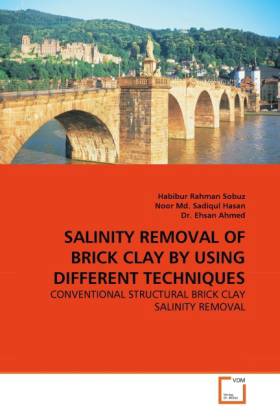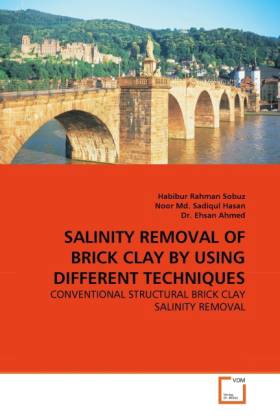
Door een staking bij bpost kan je online bestelling op dit moment iets langer onderweg zijn dan voorzien. Dringend iets nodig? Onze winkels ontvangen jou met open armen!
- Afhalen na 1 uur in een winkel met voorraad
- Gratis thuislevering in België vanaf € 30
- Ruim aanbod met 7 miljoen producten
Door een staking bij bpost kan je online bestelling op dit moment iets langer onderweg zijn dan voorzien. Dringend iets nodig? Onze winkels ontvangen jou met open armen!
- Afhalen na 1 uur in een winkel met voorraad
- Gratis thuislevering in België vanaf € 30
- Ruim aanbod met 7 miljoen producten
Zoeken
Salinity Removal of Brick Clay by Using Different Techniques
CONVENTIONAL STRUCTURAL BRICK CLAY SALINITY REMOVAL
Habibur Rahman Sobuz, Noor MD Sadiqul Hasan, Ehsan Ahmed
Paperback | Engels
€ 48,45
+ 96 punten
Omschrijving
The removal of salinity from clay during manufacturing period of bricks has proven to be an effective solution for better structural performance. Salinity effect is harmful for brick. This book aims to investigate the removal of salinity from clay by different removal techniques for the purpose of producing good quality bricks. The water salinity was also reduced by using mango and tea leaves. Four different processes have been adopted for the removal of clay salinity under different stages of environmental exposure condition. The test results indicated that immersion process of leached burning clay under 9000c temperature showed maximum salinity removal compared to that of other processes. The burnt brick reduced the salinity from 183 mg/l to 2.5 mg/l and also the burnt brick salinity after immersion technique becomes 1.85 mg/l. Mango leaves and used tealeaves reduced the salinity of water significantly and it's influence the elimination of clay salinity. Finally, the variations of brick clay salinity with different parameters were identified and comparison of test results incorporating rational suggestions with conventional manufacture and use of brick.
Specificaties
Betrokkenen
- Auteur(s):
- Uitgeverij:
Inhoud
- Aantal bladzijden:
- 68
- Taal:
- Engels
Eigenschappen
- Productcode (EAN):
- 9783639337082
- Verschijningsdatum:
- 3/03/2011
- Uitvoering:
- Paperback
- Formaat:
- Trade paperback (VS)
- Afmetingen:
- 152 mm x 229 mm
- Gewicht:
- 113 g

Alleen bij Standaard Boekhandel
+ 96 punten op je klantenkaart van Standaard Boekhandel
Beoordelingen
We publiceren alleen reviews die voldoen aan de voorwaarden voor reviews. Bekijk onze voorwaarden voor reviews.











